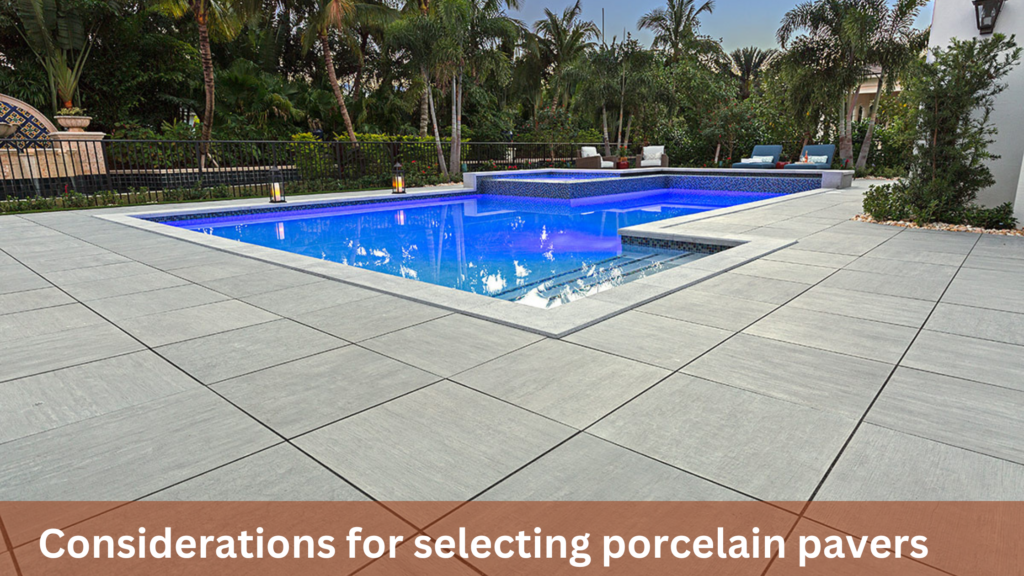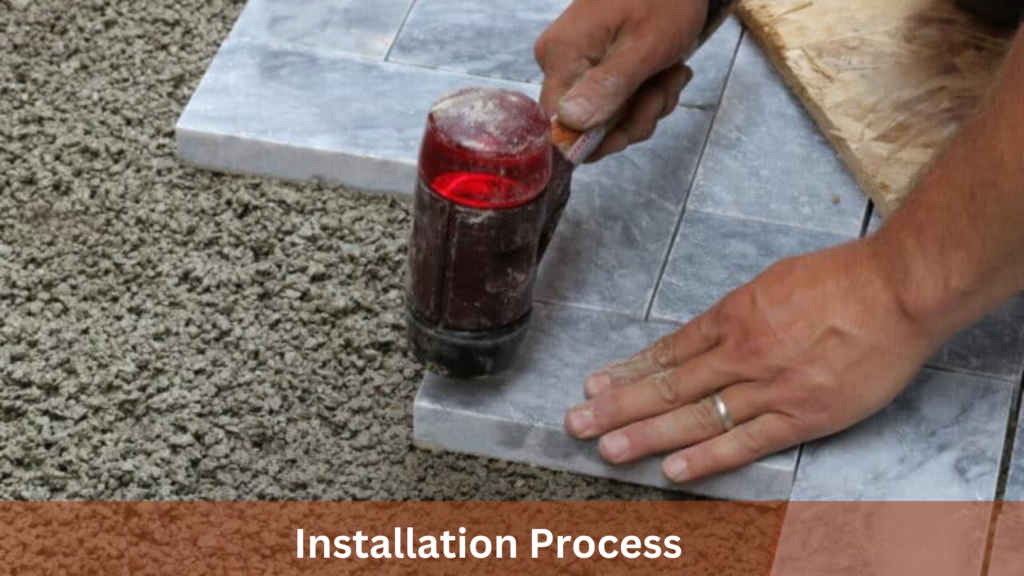
Choosing the right pavers for your patio can be overwhelming, with many options.
Making the wrong choice can lead to costly maintenance, mismatched aesthetics, and poor durability, turning your dream patio into a nightmare.
This guide will help you navigate the selection process, providing expert tips on choosing the perfect porcelain pavers that combine beauty, durability, and practicality for your ideal outdoor space.
What factors should I consider when selecting porcelain pavers?

Choosing the right porcelain pavers can transform your patio into a stylish and functional space. With many options available, how do you make the right choice?
This guide covers the key factors to consider, from assessing your patio needs to understanding design and durability, helping you make an informed decision that enhances your outdoor area.
1. Assessing your patio needs
Before selecting porcelain pavers, it is crucial to assess your patio needs to ensure the best fit for your space and lifestyle. Understanding these needs will guide you in making informed choices that enhance functionality and aesthetics.
Firstly, measure your patio area accurately to determine how many pavers you need. Consider the shape and layout, including any unique features or structures that may affect the design and installation process. Accurate measurements and careful planning can help avoid unnecessary costs and ensure a smooth installation.
Next, consider how you plan to use your patio. Whether for dining, entertainment or simply relaxation, the intended use will influence the type of pavers you choose. Areas with heavy furniture or high foot traffic may require more durable options to withstand wear and tear.
Additionally, consider the local climate when selecting pavers. Porcelain pavers are excellent for various weather conditions due to their low water absorption and frost resistance, making them suitable for hot and cold climates. This versatility ensures your patio remains in good condition throughout the year.
Reflecting on the overall style of your home and garden is also essential. Choose pavers that complement your existing décor to create a cohesive look. With the variety of designs available in porcelain pavers, finding one that matches your aesthetic preferences should be straightforward.
Lastly, establish a budget for your project. While porcelain pavers can be more expensive than other materials, their durability and low maintenance can offer long-term savings, making them a worthwhile investment.
2. Considering design and aesthetics

Choosing the perfect porcelain pavers involves more than just practical considerations; design and aesthetics are crucial in creating an appealing outdoor space. Understanding the design elements can help you select pavers that enhance your patio’s beauty and harmony.
Firstly, consider the colour palette. Porcelain pavers come in various colours, from natural tones like beige, grey, and brown to more vibrant options. Choose colours that complement your home’s exterior and landscape, creating a cohesive, inviting look that enhances your outdoor area.
Next, consider the texture and finish. The texture of pavers can significantly impact the overall feel of your patio. Options include smooth, polished finishes for a sleek, modern look or textured, tumbled finishes for a more rustic and natural appearance.
Consider the desired aesthetic and the practical aspects of slip resistance and maintenance to ensure beauty and functionality.
The pattern and layout of your pavers also play a crucial role in the design. The arrangement of pavers can add visual interest and uniqueness to your patio.
Common patterns include herringbone, basketweave, and running bond. Select a pattern that aligns with your design vision and complements the size and shape of your patio, adding to the overall appeal.
Additionally, consider the size and shape of the pavers. Porcelain pavers are available in various sizes and shapes, from large-format tiles to smaller, intricate designs. The size and shape you choose can influence your patio space’s overall aesthetic and functionality.
Larger pavers create a sense of openness, while smaller ones offer more design flexibility and intricate detailing.
Finally, consider complementary elements. Consider how the pavers will complement other elements in your outdoor space, such as furniture, plants, and decorative features.
The right pavers should enhance these elements and contribute to a harmonious and balanced design, creating a patio that is not only functional but also visually appealing and inviting.
3. Durability and maintenance
Understanding porcelain pavers’ durability and maintenance requirements is crucial when choosing them for your patio. High-quality porcelain pavers offer exceptional strength and longevity, making them an excellent investment for outdoor space.
Exceptional Durability Porcelain pavers are manufactured by firing at high temperatures, resulting in a dense, hard-wearing material. They resist cracking, chipping, and scratching, making them suitable for high-traffic areas and harsh weather conditions.
Weather Resistance These pavers are non-porous, which means they absorb very little water. This feature makes them highly resistant to frost damage and ideal for use in climates with freeze-thaw cycles. Additionally, their low water absorption helps prevent staining and mildew growth.
Fade Resistance Porcelain pavers are highly resistant to UV rays, ensuring their colours remain vibrant and do not fade over time, even with prolonged sun exposure.
Low Maintenance One key benefit of porcelain pavers is their low maintenance requirements. Unlike many natural stones, they do not require sealing and can be easily cleaned with water and mild detergent.
Their non-porous surface prevents dirt and grime accumulation, keeping them pristine with minimal effort.
Stain Resistance Thanks to their non-porous nature, porcelain pavers resist staining from common outdoor substances such as oil, grease, and food spills. This makes them a practical choice for patios used for dining and entertaining.
4. Slip resistance and safety

Ensuring slip resistance and safety is paramount when selecting porcelain pavers for your patio. Properly chosen pavers can prevent accidents and provide a secure outdoor environment, particularly in areas prone to getting wet.
Surface Texture Porcelain pavers come in various textures, from smooth to highly textured. For patios, especially those near pools or frequently exposed to rain, choosing pavers with a textured or matte finish can enhance slip resistance, reducing the risk of slips and falls.
R Ratings Porcelain pavers are often rated for slip resistance using the R rating system, which ranges from R9 to R13. For outdoor patios, especially those exposed to moisture, selecting pavers with an R rating of R11 or higher is advisable to ensure adequate grip underfoot.
Anti-Slip Treatments Some porcelain pavers are treated with anti-slip coatings during manufacturing. These treatments provide an additional layer of safety, making the pavers more suitable for wet environments.
Edge and Joint Considerations The spacing and type of joints between pavers can also impact slip resistance. Narrow joints and smooth edges can create a more cohesive surface, whereas wider joints or rough edges might enhance traction but could be less comfortable underfoot.
Maintenance Regular cleaning is essential to maintaining your pavers’ slip-resistant properties. Dirt, moss, and algae can build up over time, creating slippery surfaces. Using a mild detergent and water to clean your pavers will help preserve their texture and safety features.
5. Climate considerations
Selecting the perfect porcelain pavers for your patio requires careful consideration of your local climate. Different weather conditions can affect the performance and longevity of your pavers, so it’s essential to choose ones that are well-suited to your environment.
Temperature Extremes Porcelain pavers are highly resistant to temperature fluctuations. They can withstand high heat and freezing conditions without cracking or warping, making them ideal for regions with significant temperature variations.
Frost Resistance In areas prone to frost, it’s crucial to choose pavers that are frost-resistant. Porcelain pavers have low water absorption rates, which prevent them from absorbing moisture that can freeze and cause the pavers to crack. This feature ensures durability during freeze-thaw cycles.
Heat Tolerance For regions with hot climates, porcelain pavers are an excellent choice because they do not retain heat as much as other materials, such as concrete or natural stone. This means they remain cooler underfoot, providing a more comfortable patio surface in warm weather.
UV Resistance Porcelain pavers are UV-resistant, which helps maintain their colour and appearance over time. They will not fade or discolour when exposed to prolonged sunlight, ensuring your patio looks vibrant year-round.
Rain and Moisture In wetter climates, porcelain pavers’ non-porous nature prevents water absorption, reducing the risk of mould, mildew, and stains. Their slip-resistant surfaces also enhance safety in rainy conditions.
6. Budget and cost-effectiveness
Selecting the right porcelain pavers for your patio involves careful consideration of budget and cost-effectiveness.
Though often perceived as a premium choice, porcelain pavers offer excellent value for money due to their durability and low maintenance needs. Initially, the cost per square metre may appear higher than other materials.
However, their long lifespan and resistance to wear and tear translate into significant savings over time.
When planning your budget, factor in the purchase price and the installation costs. Professional installation ensures longevity and can prevent costly repairs.
Additionally, porcelain pavers require minimal upkeep, reducing long-term maintenance expenses. Their resistance to stains, scratches, and weathering means you won’t need to invest heavily in cleaning products or repairs.
Another financial advantage of porcelain pavers is their energy efficiency. Their dense structure retains heat, making them suitable for cooler climates and potentially reducing heating costs for adjacent indoor areas.
7. Installation process

Proper porcelain pavers installation is crucial for achieving a durable and aesthetically pleasing patio. Here’s a precise, step-by-step guide to ensure flawless results:
- Preparation: Begin by clearing the area of any debris and ensuring the ground is level. A compacted gravel base is essential for stability. Lay a 4-6 inch layer of crushed stone, compacting it thoroughly to provide a solid foundation.
- Laying the Base: Spread 1-2 inches of sand over the gravel base. Use a screed to level the sand, ensuring a smooth surface. This layer helps adjust the final positioning of the pavers.
- Placing the Pavers: Start at one corner and lay the porcelain pavers in your desired pattern. Ensure there is a small gap between each paver for jointing. Use spacers to maintain consistent spacing and ensure straight lines.
- Cutting Pavers: You may need to cut some pavers to fit edges or around obstacles. Use a wet saw with a diamond blade for precise cuts without damaging the pavers.
- Filling the Joints: Once all pavers are in place, fill the joints with polymeric sand. Sweep the sand into the gaps, ensuring they are filled. This step stabilises the pavers and prevents weeds from growing between them.
- Compacting: A plate compactor settles the pavers into the sand base, ensuring even contact and preventing future shifting. Be cautious when using the compactor to avoid damaging the surface of the porcelain pavers.
Conclusion
Choosing the perfect porcelain pavers for your patio involves balancing durability, design, and climate considerations. Invest in high-quality pavers to ensure long-lasting beauty and functionality.
Ready to transform your patio? Explore our extensive range of porcelain pavers today and find the perfect fit for your outdoor oasis. Visit our website or contact us for expert advice!
More To Explore

How Can I Prevent Efflorescence From Occurring on Stirling Sandstone?
You’ve just installed stunning Stirling Sandstone, and it looks perfect—but then, white, powdery stains start creeping across the surface. What is it? And more importantly,

Heritage Walling Stone in Point Cook: Ideal for Timeless Homes
Point Cook is a suburb where heritage charm and contemporary design sit side by side. As more homeowners seek to add character and distinction to


